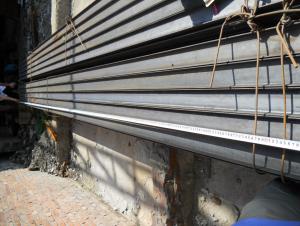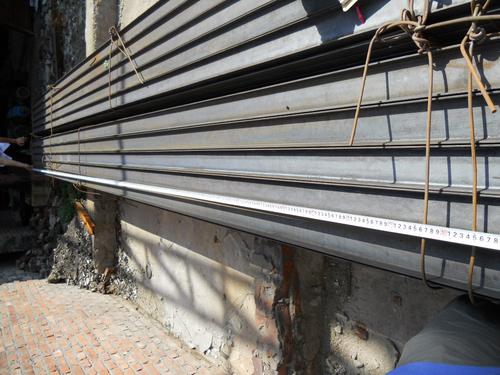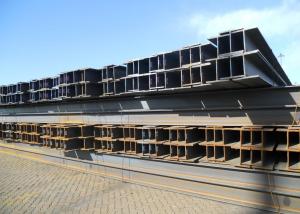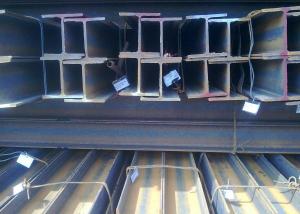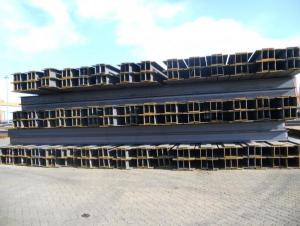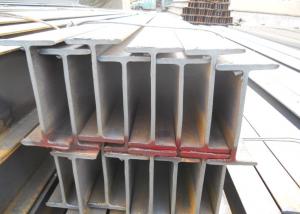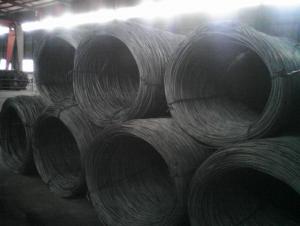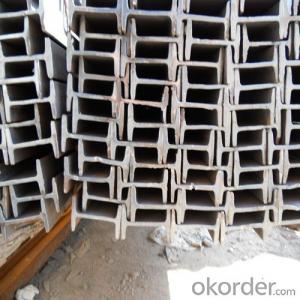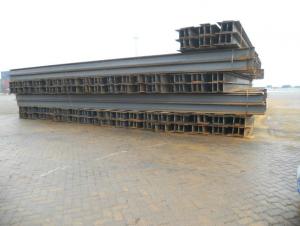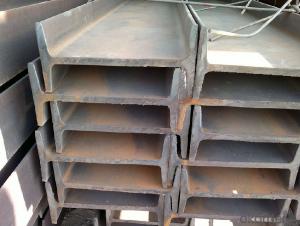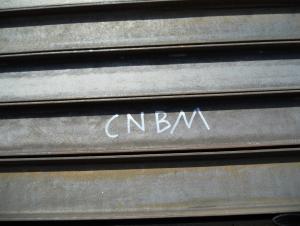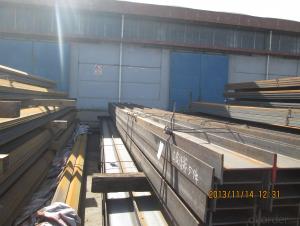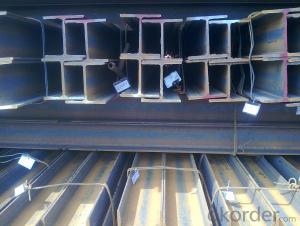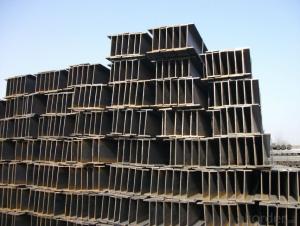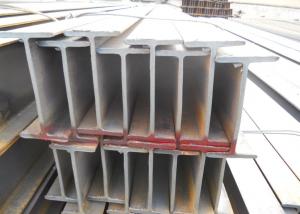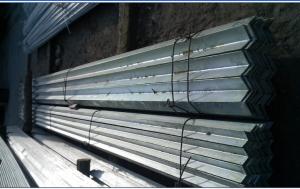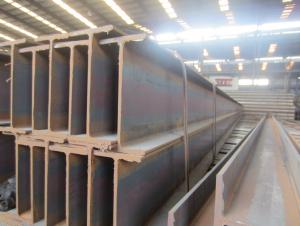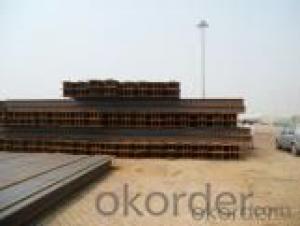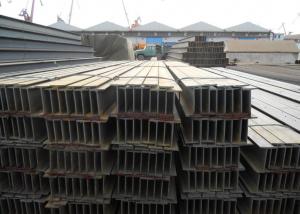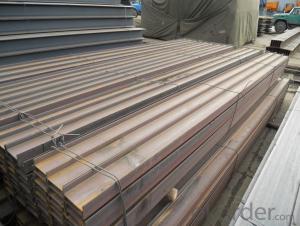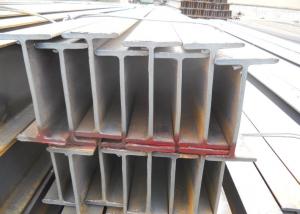HR Steel I Beams
- Loading Port:
- Tianjin
- Payment Terms:
- TT OR LC
- Min Order Qty:
- -
- Supply Capability:
- 200000 m.t./month
OKorder Service Pledge
OKorder Financial Service
You Might Also Like
Specifications of I-Beam Steel
Product name: I-Beam Steel
Production Standard: GB, BS, ASTM, EN, DIN, JIS
Grade: Q235B, Q345B, ASTM A36, SS400, S235JR, S275JR
Chemical composition
Alloy No. | Grade | C | Mn | S | P | Si |
Q235 | B | 0.12%-0.20% | 0.3%-0.7% | <=0.045% | <=0.045% | <=0.3% |
Length: 5.8M, 6M, 8M, 9M, 10M, 12M or as the requirements of the buyer
Sizes: 80MM-270MM
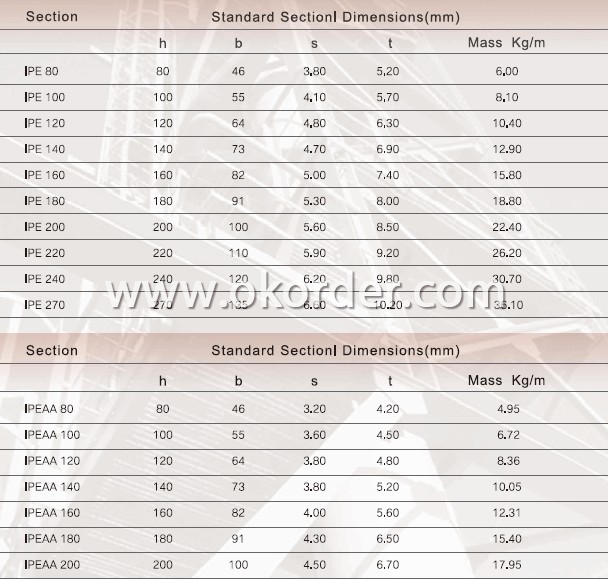
Applications of I-Beam Steel
Widely used in various building structures and engineering structures such as roof beams, bridges, transmission towers, hoisting machinery and transport machinery, ships, industrial furnaces, reaction tower, container frame and warehouse etc.
Package and Delivery
1. Package: All the products will be tired by wire rod in bundles and then put into containers 20', 40' or in bulk cargo.
Or according the requirements of the customers. Each bundle will be hung a CNBM label, which will include the information of our trademark, size, material, lengh, standard, etc. Normally, each bundle contain 50 pieces.
Bundle weight: not more than 3.5MT for bulk vessel; less than 3 MT for container load
But we can also make the bundles as the requriement of you.
2. Delivery: Within 45 days after getting the L/C ORIGINAL or the advance payment by T/T.
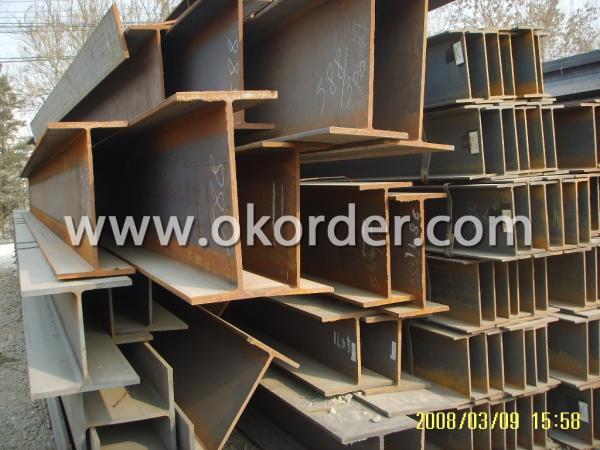
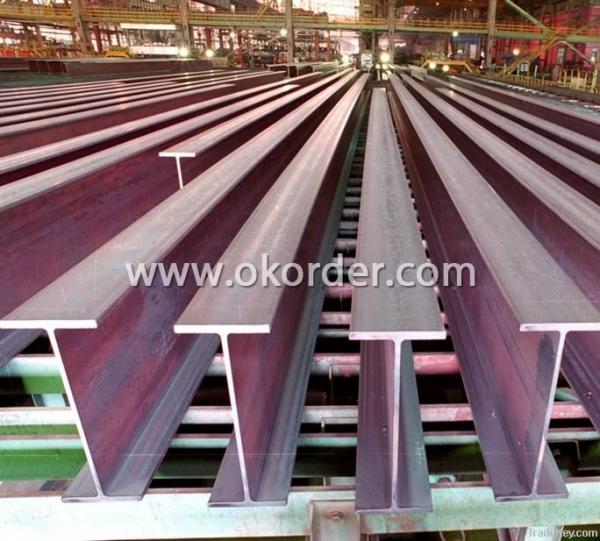
Production flow of I-Beam Steel
Material prepare (billet) —heat up—rough rolling—precision rolling—cooling—packing—storage and transportation
- Q: Can steel H-beams be used in residential pergola or canopy structures?
- Yes, steel H-beams can be used in residential pergola or canopy structures. Steel H-beams are known for their strength and durability, making them suitable for supporting heavy loads and providing structural stability. They can withstand various weather conditions, including wind, rain, and snow, ensuring the longevity and safety of the pergola or canopy structure. Moreover, steel H-beams offer a sleek and modern appearance, adding an aesthetic appeal to the overall design. However, it is essential to consult with a structural engineer or a professional contractor to ensure proper installation and adherence to local building codes and regulations.
- Q: What are the common design mistakes to avoid when using steel H-beams?
- To ensure structural integrity and safety, it is important to avoid several common mistakes when using steel H-beams in design. These mistakes can have detrimental effects on the performance of the structure. The following are some of the key mistakes to avoid: 1. Improper beam sizing: One mistake to be cautious of is selecting an H-beam size that is inadequate for the intended load. This can result in structural failure or excessive deflection. To accurately determine the required beam size, it is essential to calculate it based on the expected loads and consult structural engineering guidelines or professionals for appropriate sizing. 2. Incorrect beam placement: It is crucial to ensure that H-beams are correctly positioned and aligned. Misalignment or incorrect spacing can compromise the load-bearing capacity and stability of the structure. To ensure proper placement, it is important to adhere to the structural design plans and guidelines. 3. Insufficient connection strength: Another mistake to avoid is using improper or inadequate connections between H-beams and other structural elements. Insufficient connection strength can lead to failure or inadequate load transfer. To ensure structural integrity, it is necessary to employ proper connection design, such as welding or bolted connections. 4. Inadequate bracing: Failing to provide adequate bracing for H-beams can result in excessive deflection and instability. Bracing helps to resist lateral loads and prevent buckling of the beams. To ensure stability, it is important to carefully consider the bracing requirements and incorporate them into the design. 5. Neglecting corrosion protection: Steel H-beams are susceptible to corrosion, especially in environments with high moisture or aggressive chemicals. Neglecting proper corrosion protection measures can lead to premature deterioration and compromise the structural integrity of the beams. To protect the steel from corrosion, it is essential to apply coatings, such as paint or galvanization. 6. Disregarding thermal expansion: Steel H-beams undergo expansion and contraction with temperature changes. Ignoring the thermal expansion and not providing sufficient allowances for movement can result in stress accumulation and potential failure. To prevent structural problems, it is necessary to take into account thermal expansion and contraction during the design process. To avoid these common design mistakes, it is crucial to seek guidance from structural engineering guidelines, codes, and professionals. They can provide accurate calculations, proper sizing, and guidance tailored to the specific project requirements.
- Q: What are the common defects found in steel H-beams?
- Steel H-beams may have various defects that can be commonly observed. Surface imperfections, including scratches, pits, or dents, are among the most frequent defects. These imperfections may arise during the manufacturing process or due to mishandling during transportation or storage. Another defect that is commonly found in H-beams is related to welding. Since H-beams are typically created by welding different sections together, improper welding techniques can result in defects like cracks, lack of fusion, or excessive weld spatter. Misalignments are also prevalent defects in steel H-beams. When the flanges or webs of the beam are not aligned properly, it can cause an uneven or twisted shape. Such misalignments can compromise the overall structural integrity of the beam and necessitate corrective actions for ensuring proper functionality. Furthermore, dimensional deviations can be detected in H-beams. These deviations may involve variations in length, width, or height, which can have an impact on the beam's stability and load-bearing capacity. Lastly, corrosion is another defect that may affect steel H-beams, particularly when they are exposed to outdoor or corrosive environments. If the beam lacks proper protection through coatings or if there are gaps in the protective layer, rust formation and deterioration of the steel can occur. In conclusion, it is crucial to inspect H-beams for these common defects to guarantee their quality and structural integrity. Consistent maintenance, appropriate handling, and adherence to manufacturing standards can effectively prevent these defects and ensure the long-lasting performance of the beams.
- Q: What are the different connection types for steel H-beams?
- Depending on the specific application and structural requirements, steel H-beams can be connected using various types of connections. One commonly used connection type is the welded connection, which involves welding the H-beams together using heat and pressure. This method creates a durable and strong connection capable of withstanding significant loads. Welded connections are often preferred for heavy-duty applications where strength is a primary concern. Another option is the bolted connection, where bolts or screws are used to connect the H-beams. Bolted connections offer the advantage of easy disassembly and reassembly if needed. They also provide some flexibility and adjustment during installation. However, bolted connections may not be as strong as welded connections and may require periodic maintenance to ensure their integrity. Pinned connections are another choice, where pins or dowels allow for rotation at the joint. These connections are often used in structures that require flexibility or anticipate movement, such as bridges or seismic-resistant buildings. Pinned connections allow for movement and rotation at the joint, which helps dissipate forces and reduce stress concentrations. Additionally, there are specialized connection methods like moment connections and shear connections. Moment connections enable the transfer of bending moments between the connected beams, while shear connections are designed to transfer shear forces. These specialized connections are used in structural designs that require consideration of specific loadings and requirements. The choice of connection type for steel H-beams depends on factors including load requirements, structural design, expected movement, and ease of installation. It is advisable to consult with a structural engineer or professional to determine the most suitable connection type for a particular application.
- Q: Can steel H-beams be used for supporting communication towers?
- Certainly, communication towers can indeed be supported by steel H-beams. Construction projects often rely on steel H-beams due to their impressive strength and ability to bear heavy loads. These beams offer exceptional structural support and can endure substantial forces, making them an ideal choice for supporting communication towers. The H-shaped design of these beams ensures a larger surface area, enhancing stability and reducing the likelihood of collapse. What's more, steel H-beams boast a lengthy lifespan and demand minimal maintenance, making them both cost-effective and dependable for supporting communication towers.
- Q: How should the steel H columns in the middle of the gable be placed?
- The surface of the mountain wall is wide and high, and the wind load is great. The wind load, the wall itself is unable to resist and needs the steel column to bear, so this column is called "wind resistant column"
- Q: How do steel H-beams connect to other structural elements?
- Steel H-beams can connect to other structural elements in a variety of ways depending on the specific design and engineering requirements of the project. One common method is through the use of bolts or welds. When connecting to other steel components, such as columns or beams, H-beams are often bolted together using high-strength bolts. These bolts are inserted through pre-drilled holes in the flanges (horizontal top and bottom sections) of the H-beam and then tightened with nuts. This creates a secure and rigid connection between the H-beam and the other structural elements. Welding is another method used to connect steel H-beams to other structural elements. In this case, the flanges of the H-beam are welded to the adjacent components, ensuring a strong and permanent connection. Welding is often preferred in situations where high load-bearing capacity and structural integrity are crucial. In addition to bolts and welds, other connection methods such as connectors or brackets can also be used depending on the specific requirements of the project. These connectors or brackets are often designed to provide additional strength and stability to the connection between the H-beam and other structural elements. It is important to note that the connection method used for steel H-beams depends on various factors, including the load-bearing capacity, structural design, and safety regulations. These factors are carefully considered by structural engineers and designers to ensure that the connection is strong, secure, and able to withstand the forces and loads imposed on the structure.
- Q: How is the weight of H steel calculated?
- H section steel is a kind of economical section high efficiency profile with more optimized sectional area distribution and stronger weight ratio. It is named after the English letter "H". Because all the sections of H steel are arranged at right angles, H steel has been widely used in all directions for its advantages of high bending resistance, simple construction, cost saving and light weight.
- Q: What are the different types of coatings available for steel H-beams?
- Steel H-beams have several different types of coatings available, each with its own unique benefits and properties. Some commonly used coatings for steel H-beams include: 1. Galvanized Coatings: Galvanized coatings are widely used for steel H-beams. This involves applying a layer of zinc to the steel surface through hot-dip or electroplating. Galvanized coatings provide excellent corrosion resistance, making them ideal for outdoor or moisture/chemical-exposed applications. 2. Epoxy Coatings: Epoxy coatings offer great durability and chemical resistance. They are applied as a liquid and then cured to create a protective layer. Epoxy coatings provide superior protection against corrosion and abrasion, making them suitable for harsh environments like chemical plants or marine structures. 3. Powder Coatings: Powder coatings are popular for steel H-beams due to their durability and aesthetic appeal. Applied as a dry powder and cured with heat, they form a hard protective layer. Powder coatings resist chipping, scratching, and fading, making them ideal for applications where appearance matters. 4. Paint Coatings: Paint coatings are a cost-effective option for protecting steel H-beams. Depending on specific requirements, acrylic, alkyd, or epoxy-based paints can be used. Paint coatings offer good corrosion resistance and can be customized for different colors or environmental conditions. 5. Fire-resistant Coatings: Fire-resistant coatings are designed to protect against high temperatures and flames. They help prevent weakening or collapsing of steel H-beams in case of fire. Fire-resistant coatings are commonly used in buildings, bridges, or structures where fire safety is a concern. Choosing the right coating for steel H-beams depends on factors like corrosion resistance, durability, aesthetics, and fire protection requirements. Consulting with professionals or coating manufacturers can help determine the most suitable type of coating for a specific application and environment.
- Q: Are steel H-beams suitable for use in the construction of cultural centers or theaters?
- Yes, steel H-beams are suitable for use in the construction of cultural centers or theaters. Steel H-beams are widely used in the construction industry due to their high strength and durability. They provide excellent load-bearing capabilities, making them ideal for supporting the weight of large structures such as cultural centers or theaters. Additionally, steel H-beams have the advantage of being able to span long distances, allowing for more open and flexible designs in these types of buildings. Moreover, steel is a sustainable and environmentally-friendly material, making it a preferred choice for construction projects. Overall, steel H-beams are a reliable and suitable option for the construction of cultural centers or theaters.
Send your message to us
HR Steel I Beams
- Loading Port:
- Tianjin
- Payment Terms:
- TT OR LC
- Min Order Qty:
- -
- Supply Capability:
- 200000 m.t./month
OKorder Service Pledge
OKorder Financial Service
Similar products
Hot products
Hot Searches
Related keywords
